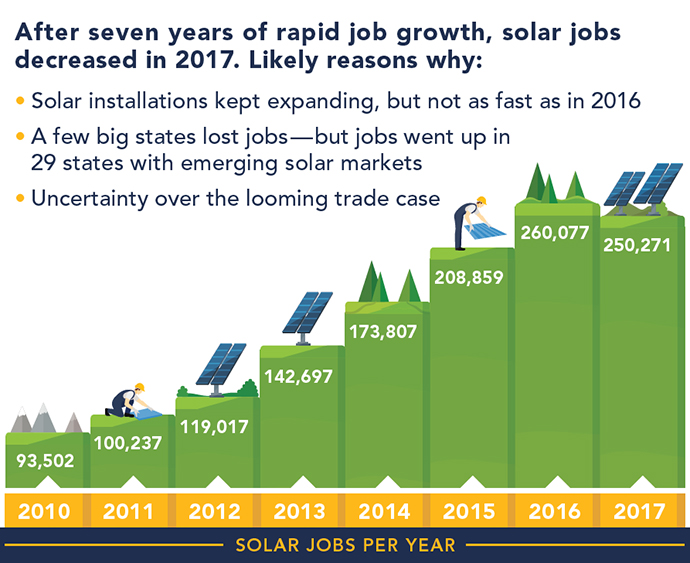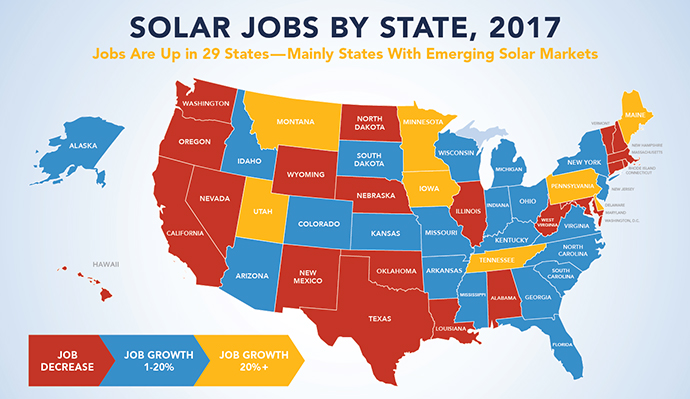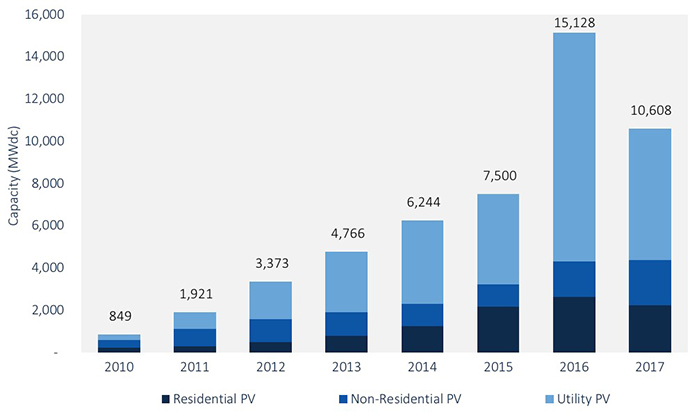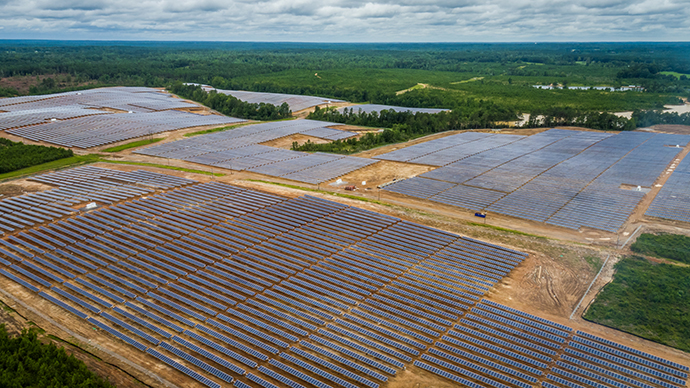In February the Solar Foundation released its National Solar Jobs Census 2017 — two days before new tariffs on foreign solar cells and modules, announced in January, came into effect. For many observers, it was a case of “Enjoy these numbers now, because they’re about to plunge as fast as solar power generation in a rainstorm.”
The tariffs were implemented by the Trump administration because of the deleterious effects of product dumping by cell and module makers in China on the business of now-defunct US solar companies such as Georgia-based Suniva and California-based Stion Solar, which shuttered a plant in Mississippi last fall and faces major debts. But their woes must be stacked against the woes of solar installers and projects nationwide, who will now face higher prices.

The contrast was evident in Suniva’s own state, where Georgia Power continues to pledge more capital investment in solar even as regulators bemoan the tariffs.
“Even though I was the first statewide elected official to support President Trump and have been supportive of the President so far, I am disappointed in his decision,” said Georgia Public Service Commissioner Lauren “Bubba” McDonald in a January 24 release after the 30-percent tariffs on imported solar panels were announced. “These tariffs will increase the price of the solar panels. Where there is increased price there is lower demand and lower demand means fewer installations and fewer jobs.” McDonald was one of a handful of state utility regulators who testified in opposition to the tariffs during an International Trade Commission hearing in August 2017.
Renewable energy use, especially solar, has grown robustly in Georgia, with big projects at the state’s five major military installations and in utility scale and community solar. Georgia Power said this month it’s added 970 MW of solar capacity in recent years, including power purchase agreements (PPAs) for 510 MW of new solar projects to be built as part of the company’s Renewable Energy Development Initiative (REDI). Among three major projects under the REDI program, First Solar, through its subsidiary Twiggs County Solar LLC, entered into a PPA with Georgia Power and will build a 200-MW solar installation on 2,000 acres of land in Twiggs County near Warner Robins. With anticipated completion in 2019, it is expected to be the largest stand-alone photovoltaic solar plant in the southeastern United States.
This has been done below or at avoided cost, which is paying for the least cost energy supply and with no state subsidies and mandates, McDonald asserted in January. “Though the decision is disappointing,” he said of the tariffs, “there is some light at the end of the tunnel,” as the tariff will reduce by 5 percent each year for the next four years, with a final tariff of 15 percent.
Here’s the tariff schedule:
| Year 1 | Year 2 | Year 3 | Year 4 | |
| Safeguard Tariff on Modules and Cells | 30% | 25% | 20% | 15% |
| Cells Exempted from Tariff | 2.5 gigawatts | 2.5 gigawatts | 2.5 gigawatts | 2.5 gigawatts |
The first 2.5 gigawatts of imported solar cells will be exempt from the safeguard tariff in each of those four years. The U.S. Trade Representative (Robert Lighthizer) will engage in discussions among interested parties that could lead to positive resolution of the separate antidumping and countervailing duty measures currently imposed on Chinese solar products and U.S. polysilicon.
“The goal of those discussions must be fair and sustainable trade throughout the whole solar energy value chain, which would benefit U.S. producers, workers, and consumers,” said the USTR announcement on January 23. “Following successful trade cases filed by the domestic industry, which levied 40 percent tariffs on Chinese solar imports, China moved production elsewhere and evaded U.S. relief, while maintaining capacity. Today, China dominates the global supply chain and, by its own admission, is looking to increase its capacity to account for 70 percent of total planned global capacity expansions announced in the first half of 2017.”
Leaders Shine
According to the Solar Foundation, Georgia ranked 11th in solar jobs growth between 2016 and 2016, adding 386 jobs for a total of 4,310.
Nationwide, solar employment declined 3.8 percent, from 260,077 jobs in 2016 to 250,271 in 2017. It’s the first time that jobs have decreased since the first Solar Jobs Census was released in 2010. Demand-side sectors (installation, sales & distribution, and project development) lost approximately 7,500 jobs in 2017, while the manufacturing sector lost about 1,200 jobs. Tariffs should ease the manufacturing
At the same time, the solar workforce increased by 168 percent in the past seven years, from about 93,000 jobs in 2010 to over 250,000 jobs in 2017. And even last year as national numbers declined, solar jobs increased in 29 states and the District of Columbia, and in major metro areas.
“Our solar jobs map shows that many states and cities bucked the national trend and enjoyed significant jobs growth in 2017,” said Andrea Luecke, president and executive director of The Solar Foundation, choosing to ignore the topic of tariffs when the numbers came out in February. “As solar technologies rapidly become more affordable and abundant, solar jobs nationwide have nearly tripled since 2010. These jobs are in solar installation, project development, sales and marketing, manufacturing, engineering, and many other skill areas.”

“Over the past year, the U.S. solar industry provided high-quality jobs to more than 250,000 Americans — jobs that are available to a wide cross-section of talents and educational backgrounds,” said George Hershman, president of Swinerton Renewable Energy. “While the industry faces challenges ahead, including higher costs as a result of the new tariffs, the demand for low-cost, reliable, and sustainable energy shows no sign of slowing down.”
“Although uncertainty over the tariff restrained the industry in recent months, the fact remains that solar energy is the lowest-cost, cleanest, most abundant and accessible energy source in the world,” said Lynn Jurich, co-founder and CEO of Sunrun. “Sunrun expanded into seven new markets last year and we will continue to create valuable local jobs, and bring new solar products and services to Americans.”
A separate jobs report from the Environmental Defense Fund, released the very day the new tariffs were announced in January, said uncertainty centered on the future of renewable energy tax incentives and the pending tariff on modules, had led to a 22-percent decline in cumulative 2017 renewable energy installations as compared to the previous year, when solar and wind installations comprised 65 percent of installed electric capacity and for the third year in a row exceeded the installed capacity of all other electricity sources combined.
From 2012 to 2017, solar employment grew nine times faster than the overall US economy, and one in every 100 new jobs was a solar job.
California remained the state with the leading number of solar jobs in 2017 (86,414), though jobs in the state declined 14 percent from 2016. Among states that saw solar job growth, the state that added the most jobs in 2017 was Utah, followed by Minnesota, Arizona, New Jersey, and New York.
“Metropolitan areas and counties in diverse parts of the country saw significant job growth in 2017,” said the Solar Foundation. “The metro area with the highest total number of solar jobs was San Francisco-Oakland-Fremont, California, at 24,474 jobs, though employment declined 6 percent from 2016. Some of the metro areas where jobs grew significantly in 2017 include greater Provo-Orem, Utah (3,798 total jobs), New York-North New Jersey-Long Island, New York (12,038 jobs); Minneapolis-St. Paul-Bloomington, Minn. (3,803 jobs); Phoenix-Mesa-Scottsdale, Ariz. (7,204 jobs); and Philadelphia-Camden-Wilmington (2,319 jobs).”
“Philadelphia has taken several steps to expand solar development, including our work to achieve SolSmart Gold designation, and launching the Solarize Philly program,” said Philadelphia Mayor Jim Kenney. “We are committed to reducing citywide carbon emissions 80 percent by 2050 and transitioning to a 100 percent clean energy future. A solid solar workforce is key to achieving those goals.”
In 2017, the U.S. solar market expanded, adding double-digit gigawatt solar photovoltaic (PV) additions for the second year in a row. According to the newly released U.S. Solar Market Insight Report 2017 Year-in-Review from GTM Research and the Solar Energy Industries Association (SEIA), the solar industry installed 10.6 gigawatts (GW) of new PV capacity in 2017, led by strong growth in the corporate and community solar segments.
While overall growth was down from the 15 GW installed in 2016, last year’s capacity addition still represents 40 percent growth over 2015’s installation total.
“The solar industry delivered impressively last year despite a trade case and market adjustments,” said SEIA President and CEO Abigail Ross Hopper. “Especially encouraging is the increasing geographic diversity in states deploying solar, from the Southeast to the Midwest, that led to a double-digit increase in total capacity.”
The non-residential market segment got its moment in the spotlight in 2017, growing 28 percent year-over-year, notching its fourth straight year of annual growth. Last year in particular saw an “explosion” in the community solar market, led by Minnesota and Massachusetts.
"Minnesota headlined a banner year for community solar, with more megawatts installed in that state than total U.S. community solar installations in all of 2016," said Austin Perea, GTM Research solar analyst and co-author of the report. "We expect community solar to diversify geographically in 2018, with Maryland and New York to be key growth markets for the sub-segment beginning this year."
Some Will Win, Some Will Lose
As recently as the end of October 2017, the U.S. Bureau of Labor Statistics announced that the occupation of solar photovoltaic installer was projected to add 11,900 new jobs between 2016 and 2026, for an increase of 105.3 percent, largest among all occupations. The tariffs imposed by its federal brethren will likely put a dent in that forecast in the near term. But those in the solar manufacturing business hope to gain ground.

In response to a Site Selection inquiry just prior to the tariff announcement, Seth Stulgis, marketing director for defunct Stion Solar, said of its closed Mississippi plant, “Our hope is to find a buyer who will continue turn-key operations at the plant in Hattiesburg. “Any further restrictions imposed by the President will help revive discontinued US operations as well as encourage foreign manufacturers to setup factories in the US, similar to the auto manufacturing industry. We understand that several large foreign manufacturers are considering starting US manufacturing plants based on the outcome of the tariff case.”
Sturgis went on to note that, since 2011, Stion paid more than $33 million in wages to Mississippi employees and an additional $50 million to local vendors and government agencies. However, the state auditor this month revealed that Stion owes the state and local governments nearly $93 million in loan and backlogged property tax payments.
As further tariffs on imported aluminum and steel hung in the balance in early March, Abigail Ross Hopper, president and CEO of the Solar Energy Industries Association (SEIA), said, “As President Trump prepares to issue an official decision on tariffs for steel and aluminum products, we want to remind him that the net loss of jobs and the cancellation of projects as a result of his solar tariffs are real and causing damage to America’s energy economy.
U.S. Annual PV Installations, 2010-2017

“Against the backdrop of possible steel and aluminum tariffs, which add costs, particularly to large scale solar projects, we are asking President Trump and Congress to reconsider support for tariffs and adopt pro-American policies that protect American jobs,” she said. As for the help the tariffs will bring, she noted, “There has been very little interest in building substantial new solar manufacturing capacity as a result of solar tariffs. The actual number of jobs added because of solar tariffs will be negligible under the best of circumstances, while the number of jobs likely to be lost because of these tariffs is 23,000.”
Because of the federal and state policy changes and market dynamics, GTM Research lowered its base-case forecast for 2018-2022 by 13 percent. “Still, total installed U.S. PV capacity is expected to more than double over the next five years,” said their report with the SEIA, “and by 2023, more than 15 GW of PV capacity will be installed annually.”
“With 2018 being relatively insulated from the impact of tariffs due to developers’ access to tariff-free module supply, 2019 and 2020 will be most sensitive to module tariffs, seeing a 20-percent and 17-percent decrease, respectively, over our Q4 2017 forecast,” said the GTM/SEIA report. “Existing power-purchase agreements for 2019 and 2020 that structured contracts with module pricing assumptions below $0.40/W will be at a high risk of cancellation or delay.”

